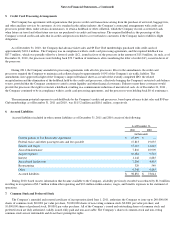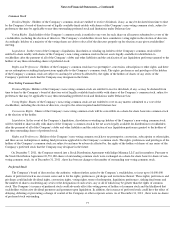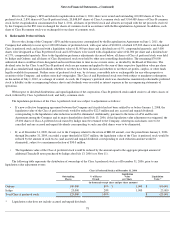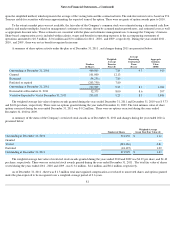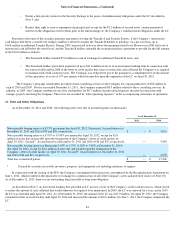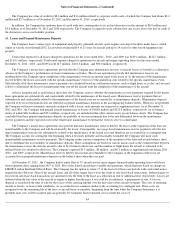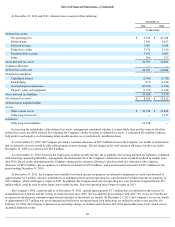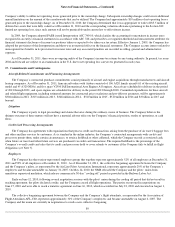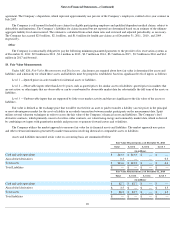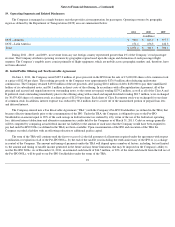Spirit Airlines 2011 Annual Report Download - page 96
Download and view the complete annual report
Please find page 96 of the 2011 Spirit Airlines annual report below. You can navigate through the pages in the report by either clicking on the pages listed below, or by using the keyword search tool below to find specific information within the annual report.
Notes to Financial Statements—(Continued)
maintenance events that are covered by reserves on deposit with the relevant lessor, or routine maintenance costs that are recorded in
maintenance expense.
During 2011, the Company entered into sale and leaseback transactions with third party aircraft lessors for the sale and leaseback of two
Airbus A320 aircraft and one spare engine which resulted in deferred losses of $10.6 million, which are included in security deposits and other
long term assets within the balance sheet. The deferred losses will be recognized as rent expense on a straight line basis over the term of the
respective operating leases. The Company had agreements in place prior to the delivery of these aircraft which resulted in the settlement of the
purchase obligation by the lessor and the refund of $6.7 million in pre-delivery deposits from Airbus. The refunded pre-delivery deposits have
been disclosed in the statement of cash flows as investing activities within pre-delivery deposits, net of refunds. On the engine sale and
leaseback, the Company took delivery of the engine and subsequently completed a sale and leaseback of the engine. Cash outflows related to the
purchase of the engine have been disclosed in the statement of cash flows as investing activities within purchases of property and equipment and
the cash inflows from the sale of the engine as financing activities within proceeds received on sale lease back transactions. All of the leases
from these sale and leaseback transactions are accounted for as operating leases. Under the terms of the lease agreements, the Company will
continue to operate and maintain the aircraft. Payments under the lease agreements are fixed for the term of the lease. The lease agreements
contain standard termination events, including termination upon a breach of the Company's obligations to make rental payments and upon any
other material breach of the Company's obligations under the leases, and standard maintenance and return condition provisions. Upon a
termination of the lease due to a breach by the Company, the Company would be liable for standard contractual damages, possibly including
damages suffered by the lessor in connection with remarketing the aircraft or while the aircraft is not leased to another party.
Future minimum lease payments under noncancelable operating leases with initial or remaining terms in excess of one year at
December 31, 2011 were as follows:
As part of the Company’s risk management program, the Company from time to time uses a variety of financial instruments, primarily
costless collar contracts, to reduce its exposure to fluctuations in the price of jet fuel. The Company does not hold or issue derivative financial
instruments for trading purposes.
The Company is exposed to credit losses in the event of nonperformance by counterparties to these financial instruments. The Company
periodically reviews and seeks to mitigate exposure to the counterparty’s financial deterioration and nonperformance by monitoring the absolute
exposure levels, the counterparty’s credit rating, and the counterparty’s historical performance relating to hedge transactions. The credit
exposure related to these financial instruments is limited to the fair value of contracts in a net receivable position at the reporting date. The
Company also maintains security agreements that require the Company to post collateral if the value of selected instruments falls below
specified mark-to-market thresholds. To mitigate this requirement, the Company ratably builds its hedge portfolio to targeted levels to avoid
excess exposure to specific market conditions.
The Company records financial derivative instruments at fair value, which includes an evaluation of the counterparty’s credit risk. Fair
value of the instruments is determined using standard option valuation models. Management chose not to elect hedge accounting on any of the
derivative instruments purchased through the end of 2011, 2010, and 2009 and, as a result, changes in the fair value of these fuel hedge contracts
are recorded each period in aircraft fuel expense.
85
Operating Leases
As of December 31,
Aircraft
and Spare Engine
Leases
Property Facility
Leases
Total Operating
Leases
(in thousands)
2012
$
138,532
$
8,372
$
146,904
2013
144,476
7,781
152,257
2014
144,494
5,711
150,205
2015
144,879
3,115
147,994
2016
145,725
1,025
146,750
2017 and thereafter
434,811
14,825
449,636
Total minimum lease payments
$
1,152,917
$
40,829
$
1,193,746
14.
Financial Instruments and Risk Management


